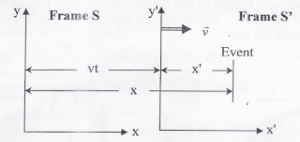Frame S is moving with velocity v in the x-direction, with no change in y. After a period of time t, Frame S’ denotes the new position of frame S.
$$\begin{aligned} x’ &= x-vt \\ y’ &= y \\ z’ &= z \\ t’ &= t \end{aligned}$$
$rightarrow$ Works for objects with speeds much less than c
However the concept of Galilean relativity does not applies to experiments in electricity, magnetism, optics and other areas.
For eg. If we assume that the laws of electricity and magnetism are the same in all inertial frames, a paradox concerning the speed of light immediately arises. This can be understood by recalling that according to electromagnetic theory, the speed of light always has the fixed value of 2.99792458 x 108 ms-1 in free space. But this is in direct contradiction to common sense.
Suppose a light pulse is sent out by an observer S’ in a car moving with velocity v. The light pulse has a velocity c relative to observer S’. According to Galilean relativity, the velocity of the pulse relative to stationary observer S outside the car should be c+v. But it is wrong as the velocity of the pulse will still be c.
To resolve the paradox, we must conclude either that
- the addition law of velocities is incorrect or that
- the laws of electricity and magnetism are not the same in all inertial frames.
Assuming that the second conclusion is true, then a preferred reference frame must exist in which the speed of light has the value c, but in any other reference frames the speed of light must have a value of greater or less than c.
Electromagnetic theory predicted that electromagnetic waves must propagate through free space with a speed equal to the speed of light. However, the theory does not require the presence of a medium for wave propagation. Hence, physicists of the 19th century, proposed that electromagnetic waves also required a medium in order to propagate – ether.
Properties of ether: Massless but rigid medium with no effect on the motion of other planets and are present everywhere even in empty space. Depicts emptiness
The laws of electricity and magnetism would take on their simplest forms in a special frame of reference at rest with respect to the ether. This frame was called the absolute frame. The laws of electricity and magnetism would be valid in this absolute frame, but they would have to modified in any reference frame moving with respect to the absolute frame.
Michelson – Morley experiment is designed to determine the velocity of Earth relative to the hypothetical ether. When Earth moves through the ether, to an experimenter on Earth, there was an “ether wind” blowing through his lab. When the apparatus was rotated, the fringe pattern is supposed to shift slightly but measurably. However, no fringe shift of the magnitude required was observed. This result contradicted the ether hypothesis and showed that it was impossible to measure the absolute velocity of Earth with respect to the ether frame.
Video of Michelson-Morley Experiment showing the failure to detect the presence of ether(both of the light enter the detector at the same time):
